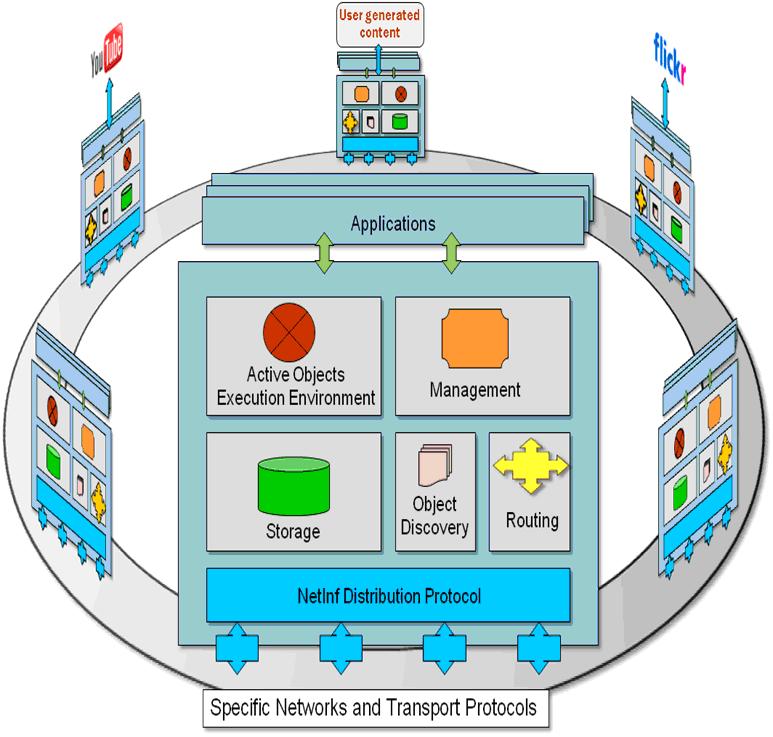Below is the 1st quarterly newsletter from the SAIL project. A printable, PDF, version of the SAIL newsletter #1 can be downloaded here.
You may subscribe to the quarterly newsletters from SAIL by entering your email address in the form below.
————————————————————————————————————————————————-
SAIL Project Newsletter, issue #1 – December 2010
Editor: Luis M. Correia
1. Editorial
Welcome to the SAIL project and our very first Newsletter. It is our belief that this quarterly update from our project is going to be something that you look forward to, that stands out in the massive flood of information that cross your way during a typical quarter of a year of work.
The SAIL project is a research project within the European Commission ICT Work Program, targeting The Network of the Future. With a birds-eye view, projects within this call are aiming at “Overcoming structural limitations of the current Internet architecture arising from an increasingly larger set of applications, of devices and edge networks to be supported”.
Now, this got me thinking – who are we to define the networks of our grandchildren?
Can we, even if we are working in the forefront of the evolution, really foresee what the Internet will look like – and how it will be used – 20 years from now? Remember that the first web-browser is less than 20 years old. Since then, we have seen many, at that time unforeseen, usages of the web emerge. The Internet, the web and the cloud will redefine themselves numerous times in the coming two decades.
So I doubt that we can predict all the usage patterns of the future. Nevertheless, I am certain that SAIL will contribute to this future, whatever it may bring. For a starter, we are now doing the work on ‘Scenarios’, describing how our foreseen technical architectures can fit into the industry architectures of tomorrow, and giving you a teaser of what to look forward to in coming Newsletters. Having that said, find a quiet place, lean back and read more about the progress of our project and our journey to come!
Under the Spotlight in this issue is Network of Information, and our work to develop a network architecture and protocols for global scale Information-Centric-Networking – an approach that has recently received considerable attention in the research community and in the industry.
Enjoy your reading!
Thomas Edwall, Project Manager.
2. Under the Spotlight: Focus on WP-B
WP-B (Network of Information – NetInf) work is motivated by recent observations and predictions for exploding capacity needs for mobile video communications, the proliferation of CDN technology for large-scale content distribution, and the growing acceptance for ICN concepts in mainstream applications, such as P2P-based distribution/streaming. WP-B is investigating how ICN concepts, such as name-based routing, receiver-oriented transport, and ubiquitous caching can be employed as cornerstones for a future network architecture.
SAIL is currently analysing technology and business aspects for applying ICN to different scenarios: the Next-Generation Mobile Communication Network scenario is an important scenario with respect to addressing current and future bandwidth demands for content/service distribution in mobile communication networks. The analysis shows that NetInf-based approach can provide significant simplifications and efficiency improvements by integrating support for in-network storage and processing capabilities into network nodes – for content distribution, but also for providing new services.
The NetInf-TV scenario explicitly addresses content-distribution-related requirements for a NetInf infrastructure. Here, we analyse how NetInf can provide CDN-like functionality – without the limitations of current CDN technology. We also analyse how NetInf can enable services in an ISP multiplay environment.
The Developing Regions scenario is focusing on robustness and resilience aspects of the NetInf technology. Here, we analyse how NetInf can help to reduce the digital divide by enabling low-cost, yet robust and reliable communication services that could be offered by a community ISP. The general proposition is that NetInf can provide a better, more robust and efficient, solution to the communication needs of communities in developing regions than the existing Internet protocols. The information-centric approach and the inherent caching features as well as its improved resilience to disruptions make NetInf a good option here.
This analysis is aligned with the overall work in SAIL on socio-economic aspects, and serves for identifying important requirements for the ICN architecture.

Figure 1: Information-centric networking node architecture
The ICN architecture work in SAIL is leveraging results from previous projects, such as 4WARD and PSIRP, and will be based on a set of architecture invariants that enable global interoperability, while providing sufficient room for domain-specific adaptations and experiments.
An important aspect of the ICN work within SAIL is migration from and interworking with existing networks and applications. WP-B is therefore actively contributing to standardisation of related and potential base technologies for ICN, such as the IETF work on access to in-network storage (DECADE) and P2P streaming (P2PSP). SAIL has established links to the ICN research community, and SAIL members are co-organising a Dagstuhl seminar on ICN together with members of the NSF-NDN project.
3. Inside SAIL: News from WPs and Themes
WP-A – Impact and Collaboration Enabling (ICE)
WP-A is called Impact & Collaboration Enabling, a name that reflects well its main missions. Starting with the collaboration part, WP-A is providing the technical coordination between the technical work packages (WP-B, WP-C and WP-D) through the Technical Manager and POET team. It also provides a set of tools and fora that is aimed at stimulating the cross communication between WPs.
WP-A has a task devoted to Migration and Standardisation, which helps the technical WPs to find the appropriate channels for the technical results to find its way into the appropriate standardisation fora. It will also support the overall migration planning for how to get from today’s Internet to a future communication network built from SAIL technology.
The Dissemination task of WPA facilitates publication of results and creates concrete opportunities for spreading SAIL technical ideas through arranging workshops and an in-depth summer school. Details of these events will be available in future newsletters, as well as from the SAIL web site.
Finally, the Socio-Economic task is currently doing a business analysis of the scenarios being developed within SAIL. It also provided two well received contributions to the Socio-Economics of the Network of the Future workshop at the FP7 Concertation meeting in Brussels, on Oct. 18-20, 2010.
WP-B – Network of Information (NetInf)
Under the spotlight in this issue.
WP-C – Open Connectivity Service (OConS)
WP-C focused so far on the description of scenarios and use-cases to be developed and covered by Open Connectivity Services. Several use-cases are considered, including wireless challenged networks, optimised services with heterogeneous content, and cloud and operator services.
To see what are main the drivers for adopting OConS, we are currently analysing these use-cases from a business viewpoint and from each stakeholder’s perspective.
Finally, we have also initiated discussions on the architectural framework and on the required mechanisms to be implemented as Connectivity Services.
WP-D – Cloud Networking (CloNe)
It has been a quick and intensive start for all of the tasks in the Cloud Networking WP. Most of the efforts have currently been put on the definition of the use cases and scenarios. The definition of clear scenarios and use-cases is crucial for the good development of our architecture. The use-cases should demonstrate the benefits of the research we will perform, from either a technical or business perspectives. Many of the use-cases enabled by cloud networking will create new business models.
Two large scenarios are being developed in CloNe. The first one addresses the issues related to the migration of enterprise IT resources to the cloud, and the new possibilities of managing businesses related to the flexibility enabled by it. The second one focuses on the distribution of media content to large audiences in an elastic manner.
In that context, the manageability of the solution and the security levels enabled by it are key questions. That is why both the management and the security tasks have started their work mapping out the technical challenges that will be addressed in the project.
Prototyping and Experimentation Theme
The SAIL consortium stands for compelling, prototype-based evidence that its approach will be a core part of the Network of the Future. To emphasise this, project results shall be demonstrated at industry-relevant events.
The objective in this theme is to ensure the necessary project-wide coordination of prototyping and experimentation activities in order to foster a roadmap for the common demonstration across WPs. The theme will collect and consolidate the project wide principles, guidelines and requirements for prototyping and experimentation.
During the on-going first phase, the theme started working by collecting initial prototyping plans from partners, and will next discuss how to consolidate these views across them. After that, the theme will drive the identification of cross-WP services and interfaces, and harmonise cross-WP platform and development issues in order to ensure effective cooperation.
Security Theme
The objectives of the Theme “Security” are to create a coherent and comprehensive security framework in which the project results can be evaluated regarding common security objectives, enforce coherent security solutions, and to understand potential misuse and remaining deficiencies. Accordingly, each WP has assigned a supporter of this theme. Its role is to maintain relation to the security theme, inform about developments and results such that the progress is harmonised.
At this time, the theme consequently participates in scenario work, depending on the commitments in security related tasks, i.e., more in WP-D, with a separate security task and less in other WPs, where security is encompassed in architectural work or elsewhere. Consequently, members of the WP-D task on security participate in developing scenarios and use cases to identify in more details the security specific challenges on Cloud Networking. Members in WP-B and WP-C elaborate on protection of NetInf and OConS technology components and the prevention of their misuse respectively.
Network Management Theme
The network management theme is defining a coherent overall management architecture based on the decentralized self-management paradigm that will be applied in NetInf, OConS, and CloNe. The theme builds on SAIL’s architectural concept of flash slices as the basic object of management, which designates a flexible and dynamic virtualized portion of an ICT infrastructure combining networking, processing, and storage. Because the management of flash slices is a novel and complex problem, the network management theme is identifying and consolidating the management-related concepts developed in each of the technical work packages in order to achieve a coherent overall solution.
In the first phase, the theme has gathered detailed information of the diverse management landscape in SAIL from a questionnaire, in which first important relations between the work packages’ management tasks could be identified. For example, both cache management and the management of forwarding tables show very similar properties in terms of distribution, embedding, and self-organization, which may lead to synergies and simplifications in the anticipated management architecture. The questionnaire furthermore identified an important relation between the network management theme and the interdomain theme, because interdomain considerations are of great importance as flash slice management will likely extend across multiple administrative domains.
4. Looking Outside: Views on SAIL
SAIL has issued a Press Release by the launching of the project. This Press Release was also translated and launched by several partners in other countries, e.g., Germany, France, Spain and Portugal. With this Press Release, the project has done a first step to its visibility, towards not only the ICT community in particular but also the society in general. Further press releases may be issued, accompanying major public achievements of the project, like public workshops and demonstration events.
The following papers have been accepted or published:
- P. Schoo, V. Fusenig, V. Souza, M. Melo, P. Murray, H. Debar, H. Medhioub and D. Zeghlache, “Challenges for Cloud Networking Security”, MONAMI 2010 – 2nd International ICST Conference on Mobile Networks and Management, Santander, Spain, Sep. 2010.
- D. Kutscher, H. Flinck and H. Karl, “Information-Centric Networking”, 6th GI/ITG KuVS Workshop on Future Internet, Hannover, Germany, Nov. 2010.
- D. Dudkowski, B. Tauhid, G. Nunzi and M. Brunner, “A Prototype for In-Network Management in NaaS-enabled Networks”, IM 2011 – 12th IFIP/IEEE International Symposium on Integrated Network Management, Dublin, Ireland, May 2011.
5. What’s Next: Coming Events
SAIL will be participating in incoming conferences and workshops:
- Information-Centric Networking Dagstuhl Seminar, Dagstuhl, Germany, Dec. 05-08, 2010.
- Future Internet Assembly, Ghent, Belgium, Dec. 16-17, 2010.
- ITG/VDE Workshop on Challenges and Solutions for Network Virtualisation, Kiel, Germany, Mar. 10-12, 2011.
- IM 2011 – 12th IFIP/IEEE International Symposium on Integrated Network Management, Dublin, Ireland, May 23-27, 2011.
- SIGCOMM 2011 Workshop on Information-Centric Networking, Toronto, Canada, Aug. 15-19, 2011.
Some conferences have paper submission deadlines in the incoming weeks:
- Future Network and MobileSummit, Warsaw, Poland, June 15-17, 2011. Deadline: Dec. 10, 2010.
- IWCMC’2011 – 7th International Wireless Communications & Mobile Computing Conference, Istanbul, Turkey, July 08–11, 2011. Deadline: Dec. 15, 2010.
To Probe Further
For more information, go to the project website (http://www.sail-project.eu), or contact SAIL through the contact web page.
Visit also the project blog, http://sail-project.eu/sailorsinn.































